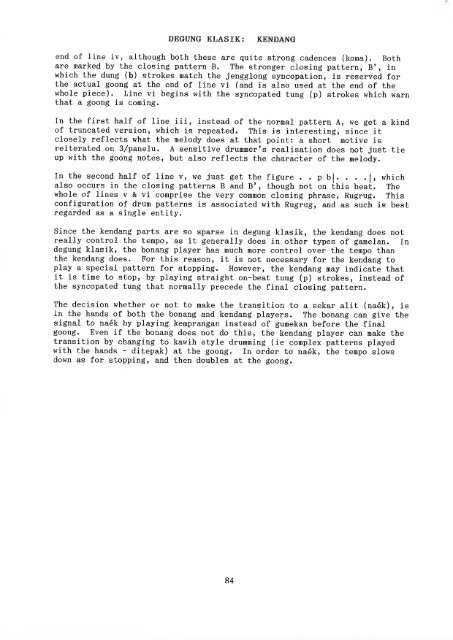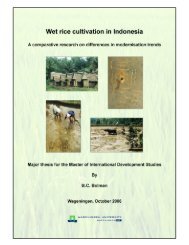Guide to Sundanese Music - Free EBooks Library
Guide to Sundanese Music - Free EBooks Library
Guide to Sundanese Music - Free EBooks Library
You also want an ePaper? Increase the reach of your titles
YUMPU automatically turns print PDFs into web optimized ePapers that Google loves.
DEGUNG KLASIK: KENDANG<br />
end of line iv, although both these are quite strong cadences (koma). Both<br />
are marked by the closing pattern B. The stronger closing pattern, B' , in<br />
which the dung (b) strokes match the jengglong syncopation, is reserved for<br />
the actual goong at the end of line vi (and is also used at the end of the<br />
whole piece). Line vi begins with the syncopated tung (p) strokes which warn<br />
that a goong is coming.<br />
In the first half of line iii, instead of the normal pattern A, we get a kind<br />
of truncated version, which is repeated. This is interesting, since it<br />
closely reflects what the melody does at that point: a short motive is<br />
reiterated on 3/panelu. A sensitive drummer's realisation does not just tie<br />
up with the goong notes, but also reflects the character of the melody.<br />
In the second half of line v, we just get the figure . . p b|. . . .|, which<br />
also occurs in the closing patterns B and B' , though not on this beat. The<br />
whole of lines v & vi comprise the very common closing phrase, Rugrug. This<br />
configuration of drum patterns is associated with Rugrug, and as such is best<br />
regarded as a single entity.<br />
Since the kendang parts are so sparse in degung klasik, the kendang does not<br />
really control the tempo, as it generally does in other types of gamelan. In<br />
degung klasik, the bonang player has much more control over the tempo than<br />
the kendang does. For this reason, it is not necessary for the kendang <strong>to</strong><br />
play a special pattern for s<strong>to</strong>pping. However, the kendang may indicate that<br />
it is time <strong>to</strong> s<strong>to</strong>p, by playing straight on-beat tung (p) strokes, instead of<br />
the syncopated tung that normally precede the final closing pattern.<br />
The decision whether or not <strong>to</strong> make the transition <strong>to</strong> a sekar alit (naek), is<br />
in the hands of both the bonang and kendang players. The bonang can give the<br />
signal <strong>to</strong> na6k by playing kemprangan instead of gumekan before the final<br />
goong. Even if the bonang does not do this, the kendang player can make the<br />
transition by changing <strong>to</strong> kawih style drumming (ie complex patterns played<br />
with the hands - ditepak) at the goong. In order <strong>to</strong> naek, the tempo slows<br />
down as for s<strong>to</strong>pping, and then doubles at the goong.<br />
84








